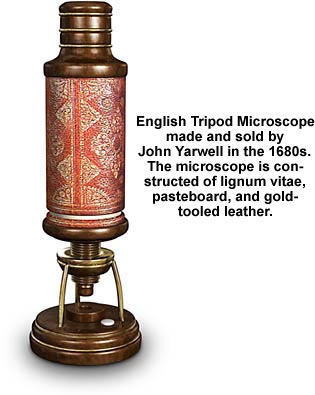Sixteenth and Seventeenth Century Microscopes
Microscopes slowly evolved from crude magnifying lenses during this period. The first recorded microscope consisted of a pair of draw tubes with a converging objective and diverging eye lens made by Dutch inventors Zacharias and Hans Janssen (Zacharias was a boy at the time).

During the second half of the seventeenth century, microscope design forked into two avenues of development. In England, instrument makers were building tripod-style microscopes from wood, pasteboard, and leather (illustrated above), while Italian designers made smaller microscopes from turned wood and brass. It was also during this period that several prominent microscopists conducted fundamental experiments that have defined microscopy throughout the ages. Pioneers such as Antoni van Leeuwenhoek, Robert Hooke, Giuseppe Campani, and Marcello Malpighi made significant discoveries that paved the road for future microscopists.
Download our Museum of Microscopy screen saver for Windows.
Janssen's Microscope - The first known compound microscope, made by Zacharias and Hans Janssen in the 1590's.
Leeuwenhoek Microscope - Antoni van Leeuwenhoek was an amateur Dutch scientist who was granted the honor of Fellowship in the Royal society for his discoveries in microscopy and high quality, but crude optical microscopes.
Early Sliding Rod Microscope - This middle seventeenth century version of the simple one-lens microscope uses a sliding rod to focus the specimen.
Early Simple Spring Microscope - Another example of a simple microscope from the seventeenth century that uses a spring to hold the specimen in place.
Jan Swammerdam Simple Microscope - Designed by the Dutch scientist Jan Swammerdam, this microscope was built sometime in the mid-1670s and utilizes small bead lenses (one or two millimeters in diameter) that produce a magnification of around 150x, similar to the microscopes of Antoni van Leeuwenhoek.
Depovilly Simple Microscope - Elegantly crafted from brass and ivory, this early French single-lens microscope holds eight specimens in its sample holder.
Italian Microscope Designs - Several of the most significant seventeenth century developments in compound microscope design and construction occurred in Italy.
Italian Wooden Compound Monocular Microscope - Made completely of wood and glass, this early Italian microscope set the design motif for later models.
Simple Italian Microscope - Having a unique design, this single-lens microscope has an creative focus mechanism that winds a cord around a peg to raise and lower the magnifying lens.
Early Italian Compound Tripod Microscope - Equipped with a wooden body and tripod base, this well-crafted microscope also has an ivory stage.
Campani Ivory Compound Monocular Microscope - The beautiful turned ivory body makes this late seventeenth-century microscope one of the most unique instruments ever manufactured.
Bonanni's Horizontal Microscope - An unusual microscope, made by Nicolas Bonanni in 1691, possessed revolutionary features such as a rack-and-pinion focus and a dual-lens condenser.
Divini's Vase Microscope - This Italian-style vase microscope was made by Eustachio Divini in the late 1600s and was used in pioneering biological studies by Marcello Malpighi.
Campani's Wooden Screw-Barrel Microscope - Giuseppe Campani, a famous Italian designer, made this screw-barrel focus microscope in 1686 that utilized a spring system to hold the specimen.
Italian Compound Tripod Microscope - Originally thought to have been made by Galileo, this elegant pasteboard and vellum Italian compound microscope is now credited to Campani.
The Galileo Microscope - This Italian-style early compound microscope was attributed (probably incorrectly) to Galileo in the late 1600's.
British Microscope Designs - The English tripod microscope was the prominent design motif during the latter half of the seventeenth century. These microscopes were only produced by a few instrument makers, but they were sold in shops throughout London and other British cities.
English Tripod Microscope - One of the first examples of a cylindrical tube microscope, supported by a tripod, that would become a common design motif for over 200 years.
John Yarwell Tripod Microscope - This elegantly styled microscope was hand-crafted from lignum vitae, pasteboard, and decorated with gold-tooled leather.
Hooke's Microscope - The Hooke design was a functional improvement over the traditional tripod motif, and even included a lighting apparatus to aid in specimen illumination.
Musschenbroek's Low Power Microscope - Johan Joosten van Musschenbroek, a famous Leyden instrument maker, designed and built this single-lens low power microscope with an elaborate jointed specimen holder.
Compound Monocular Tripod Microscope - This 24-inch high microscope is adorned in gold-stamped green vellum, and was probably made in France during the late 1600s.
Dutch Simple Brass Microscope - A simply constructed multipurpose microscope that may have a Dutch origin.
Divini Compound Monocular Microscope - Eustachio Divini, the great Italian optics pioneer and telescope maker, designed the compound monocular microscope illustrated in this section around 1668.
The Great Double Microscope - John Marshall built this popular microscope toward the end of the seventeenth century.
John Yarwell Compound Monocular Microscope - A take-off on the Great Double design by Marshall, this Yarwell instrument was state-of-the-art in the late seventeenth century.
Hartsoeker Screw-Barrel Microscope - British optician and instrument maker James Wilson is often credited with creating the screw-barrel simple microscope in 1702, but it was actually Dutch mathematics and physics professor Nicolas Hartsoeker who first invented the device.
French Simple Aquatic Microscope - Originally designed by Christiaan Huygens, this brass microscope was probably made by Louis Chapotot or his son around 1700.
